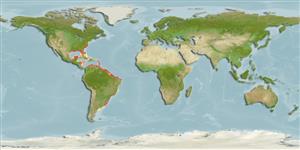>
Eupercaria/misc (Various families in series Eupercaria) >
Sciaenidae (Drums or croakers)
Etymology: Menticirrhus: Latin, mentum = beard, chin + Latin, cirrus = curly.
More on author: Linnaeus.
Environment: milieu / climate zone / depth range / distribution range
Écologie
marin; saumâtre démersal; océanodrome (Ref. 51243); profondeur ? - 40 m (Ref. 9626). Subtropical; 43°N - 42°S, 98°W - 34°W
Western Atlantic: Cape Cod in Massachussets, USA to northern Argentina.
Length at first maturity / Taille / Poids / Âge
Maturity: Lm 17.7, range 16 - ? cm
Max length : 50.0 cm TL mâle / non sexé; (Ref. 9626); common length : 30.0 cm TL mâle / non sexé; (Ref. 3702); poids max. publié: 1.1 kg (Ref. 40637)
Épines dorsales (Total) : 11; Rayons mous dorsaux (Total) : 22 - 25; Épines anales: 1; Rayons mous anaux: 7 - 8.
Inhabits coastal waters, usually over sandy-mud to hard sand bottoms. Common along beaches. Juveniles occur usually in water of lower salinity.
Chao, L.N., 1978. Sciaenidae. In W. Fischer (ed.) FAO species identification sheets for fishery purposes. West Atlantic (Fishing Area 31). Volume 4. FAO, Rome. (Ref. 3702)
Statut dans la liste rouge de l'IUCN (Ref. 130435)
Menace pour l'homme
Harmless
Utilisations par l'homme
Pêcheries: commercial; pêche sportive: oui
Outils
Articles particuliers
Télécharger en XML
Sources Internet
Estimates based on models
Preferred temperature (Ref.
123201): 14.8 - 27.9, mean 24.4 °C (based on 552 cells).
Phylogenetic diversity index (Ref.
82804): PD
50 = 0.5020 [Uniqueness, from 0.5 = low to 2.0 = high].
Bayesian length-weight: a=0.00794 (0.00734 - 0.00860), b=3.08 (3.06 - 3.10), in cm total length, based on LWR estimates for this species (Ref.
93245).
Niveau trophique (Ref.
69278): 3.5 ±0.0 se; based on diet studies.
Résilience (Ref.
120179): Milieu, temps minimum de doublement de population : 1,4 à 4,4 années (tm=2; tmax=4; Fec=28,691 (batch fecundity)).
Fishing Vulnerability (Ref.
59153): Moderate vulnerability (38 of 100).
Nutrients (Ref.
124155): Calcium = 78.1 [44.9, 148.7] mg/100g; Iron = 0.951 [0.511, 1.649] mg/100g; Protein = 21.2 [19.2, 23.5] %; Omega3 = 0.326 [0.192, 0.520] g/100g; Selenium = 22 [12, 41] μg/100g; VitaminA = 11.7 [4.4, 35.5] μg/100g; Zinc = 0.867 [0.647, 1.267] mg/100g (wet weight); based on
nutrient studies.
